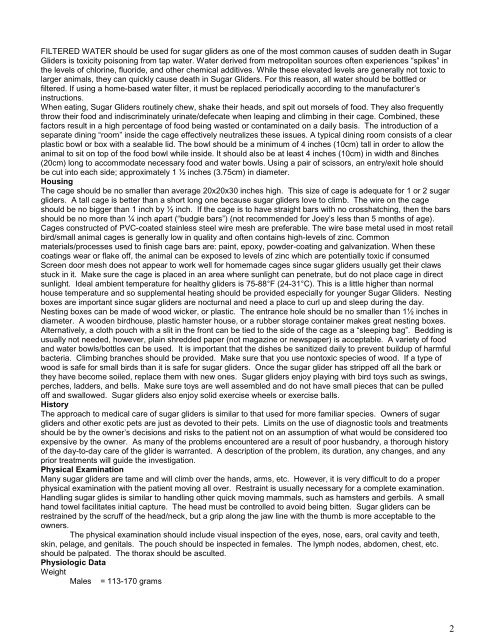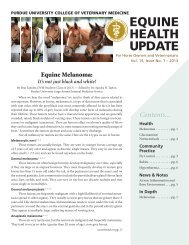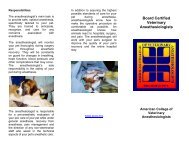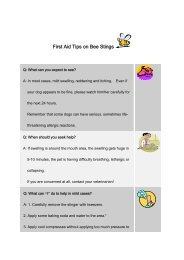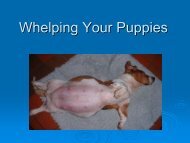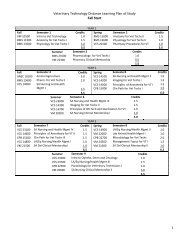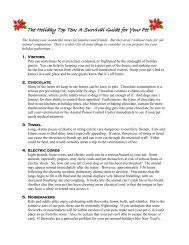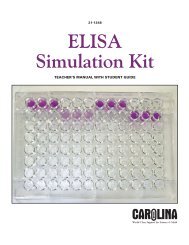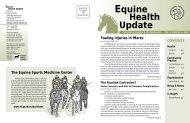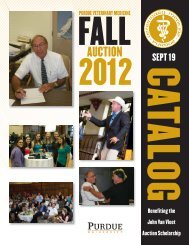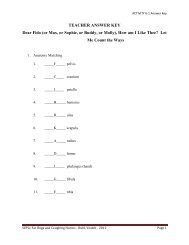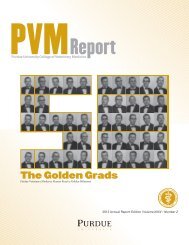Sugar Gliders - Purdue University School of Veterinary Medicine
Sugar Gliders - Purdue University School of Veterinary Medicine
Sugar Gliders - Purdue University School of Veterinary Medicine
You also want an ePaper? Increase the reach of your titles
YUMPU automatically turns print PDFs into web optimized ePapers that Google loves.
FILTERED WATER should be used for sugar gliders as one <strong>of</strong> the most common causes <strong>of</strong> sudden death in <strong>Sugar</strong><br />
<strong>Gliders</strong> is toxicity poisoning from tap water. Water derived from metropolitan sources <strong>of</strong>ten experiences “spikes” in<br />
the levels <strong>of</strong> chlorine, fluoride, and other chemical additives. While these elevated levels are generally not toxic to<br />
larger animals, they can quickly cause death in <strong>Sugar</strong> <strong>Gliders</strong>. For this reason, all water should be bottled or<br />
filtered. If using a home-based water filter, it must be replaced periodically according to the manufacturer’s<br />
instructions.<br />
When eating, <strong>Sugar</strong> <strong>Gliders</strong> routinely chew, shake their heads, and spit out morsels <strong>of</strong> food. They also frequently<br />
throw their food and indiscriminately urinate/defecate when leaping and climbing in their cage. Combined, these<br />
factors result in a high percentage <strong>of</strong> food being wasted or contaminated on a daily basis. The introduction <strong>of</strong> a<br />
separate dining “room” inside the cage effectively neutralizes these issues. A typical dining room consists <strong>of</strong> a clear<br />
plastic bowl or box with a sealable lid. The bowl should be a minimum <strong>of</strong> 4 inches (10cm) tall in order to allow the<br />
animal to sit on top <strong>of</strong> the food bowl while inside. It should also be at least 4 inches (10cm) in width and 8inches<br />
(20cm) long to accommodate necessary food and water bowls. Using a pair <strong>of</strong> scissors, an entry/exit hole should<br />
be cut into each side; approximately 1 ½ inches (3.75cm) in diameter.<br />
Housing<br />
The cage should be no smaller than average 20x20x30 inches high. This size <strong>of</strong> cage is adequate for 1 or 2 sugar<br />
gliders. A tall cage is better than a short long one because sugar gliders love to climb. The wire on the cage<br />
should be no bigger than 1 inch by ½ inch. If the cage is to have straight bars with no crosshatching, then the bars<br />
should be no more than ¼ inch apart (“budgie bars”) (not recommended for Joey’s less than 5 months <strong>of</strong> age).<br />
Cages constructed <strong>of</strong> PVC-coated stainless steel wire mesh are preferable. The wire base metal used in most retail<br />
bird/small animal cages is generally low in quality and <strong>of</strong>ten contains high-levels <strong>of</strong> zinc. Common<br />
materials/processes used to finish cage bars are: paint, epoxy, powder-coating and galvanization. When these<br />
coatings wear or flake <strong>of</strong>f, the animal can be exposed to levels <strong>of</strong> zinc which are potentially toxic if consumed<br />
Screen door mesh does not appear to work well for homemade cages since sugar gliders usually get their claws<br />
stuck in it. Make sure the cage is placed in an area where sunlight can penetrate, but do not place cage in direct<br />
sunlight. Ideal ambient temperature for healthy gliders is 75-88°F (24-31°C). This is a little higher than normal<br />
house temperature and so supplemental heating should be provided especially for younger <strong>Sugar</strong> <strong>Gliders</strong>. Nesting<br />
boxes are important since sugar gliders are nocturnal and need a place to curl up and sleep during the day.<br />
Nesting boxes can be made <strong>of</strong> wood wicker, or plastic. The entrance hole should be no smaller than 1½ inches in<br />
diameter. A wooden birdhouse, plastic hamster house, or a rubber storage container makes great nesting boxes.<br />
Alternatively, a cloth pouch with a slit in the front can be tied to the side <strong>of</strong> the cage as a “sleeping bag”. Bedding is<br />
usually not needed, however, plain shredded paper (not magazine or newspaper) is acceptable. A variety <strong>of</strong> food<br />
and water bowls/bottles can be used. It is important that the dishes be sanitized daily to prevent buildup <strong>of</strong> harmful<br />
bacteria. Climbing branches should be provided. Make sure that you use nontoxic species <strong>of</strong> wood. If a type <strong>of</strong><br />
wood is safe for small birds than it is safe for sugar gliders. Once the sugar glider has stripped <strong>of</strong>f all the bark or<br />
they have become soiled, replace them with new ones. <strong>Sugar</strong> gliders enjoy playing with bird toys such as swings,<br />
perches, ladders, and bells. Make sure toys are well assembled and do not have small pieces that can be pulled<br />
<strong>of</strong>f and swallowed. <strong>Sugar</strong> gliders also enjoy solid exercise wheels or exercise balls.<br />
History<br />
The approach to medical care <strong>of</strong> sugar gliders is similar to that used for more familiar species. Owners <strong>of</strong> sugar<br />
gliders and other exotic pets are just as devoted to their pets. Limits on the use <strong>of</strong> diagnostic tools and treatments<br />
should be by the owner’s decisions and risks to the patient not on an assumption <strong>of</strong> what would be considered too<br />
expensive by the owner. As many <strong>of</strong> the problems encountered are a result <strong>of</strong> poor husbandry, a thorough history<br />
<strong>of</strong> the day-to-day care <strong>of</strong> the glider is warranted. A description <strong>of</strong> the problem, its duration, any changes, and any<br />
prior treatments will guide the investigation.<br />
Physical Examination<br />
Many sugar gliders are tame and will climb over the hands, arms, etc. However, it is very difficult to do a proper<br />
physical examination with the patient moving all over. Restraint is usually necessary for a complete examination.<br />
Handling sugar glides is similar to handling other quick moving mammals, such as hamsters and gerbils. A small<br />
hand towel facilitates initial capture. The head must be controlled to avoid being bitten. <strong>Sugar</strong> gliders can be<br />
restrained by the scruff <strong>of</strong> the head/neck, but a grip along the jaw line with the thumb is more acceptable to the<br />
owners.<br />
The physical examination should include visual inspection <strong>of</strong> the eyes, nose, ears, oral cavity and teeth,<br />
skin, pelage, and genitals. The pouch should be inspected in females. The lymph nodes, abdomen, chest, etc.<br />
should be palpated. The thorax should be asculted.<br />
Physiologic Data<br />
Weight<br />
Males = 113-170 grams<br />
2


